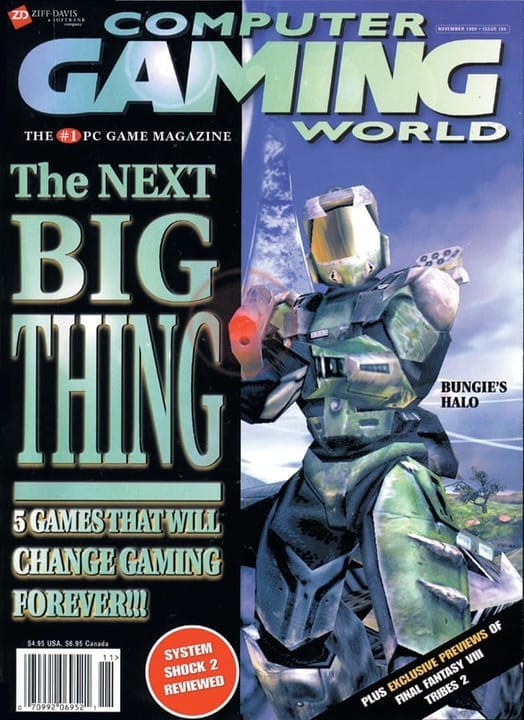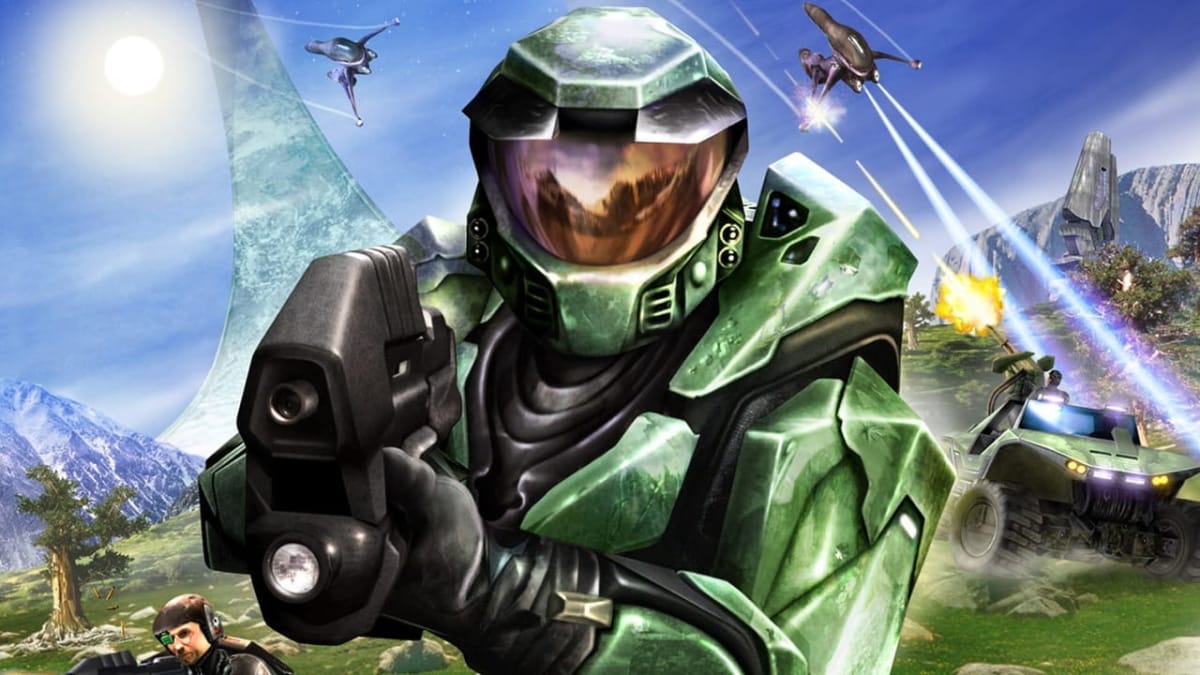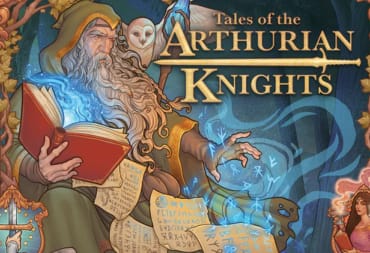Whenever a new console is launched, there is always the question of how much staying power it will have. Companies like Nintendo, Sega, and Sony have weathered many storms, and for years had successful consoles, but even they are not immune to mishaps or poor choices. It often takes a special something for a console to endure, and this usually stems from having a trademark series under its wing, a killer app that elevates the console to greatness.
In November of 2001, Microsoft entered the fray by releasing the Xbox, the first American-made console since Atari’s last attempt with the Jaguar in 1993. The Xbox was a powerful machine, offering highly detailed graphical capabilities that would be on par with low-end PC machines at the time, and was in direct competition with Sony, Sega, and Nintendo for console dominance at the time. While Sega would fizzle out and Nintendo and Sony would hold steady, the Xbox became a surprise smash that year, and much of the success has been attributed to one title in particular: Halo.
Much like Super Mario Bros., Halo: Combat Evolved became a household name almost overnight for a new generation of game players. Word of mouth of the first-person shooter spread quickly, and soon Halo would skyrocket to be the must-have game for the Microsoft console. But unlike Super Mario Bros., it was more than just a hunger for something new or clever marketing on the part of Microsoft itself—although that certainly played a part. Halo would encompass something else by giving to the masses something missing from a bygone era: a PC experience on the console.
To understand Halo’s appeal, it should be noted the pedigree of the company creating the title. Bungie was a small PC game maker that started back in the early 1990s, creating titles for Mac computers of all things. The first few games were self-funded by Bungie’s co-founders, Jason Jones and Alex Seropian, until 1994 when they struck gold with their first major franchise, Marathon.

Marathon, by all accounts, was a major hit in the gaming world, but only for a small group of PC owners. Hot off the coattails of other 3D style shooters such as Wolfenstein 3D, Doom, and Duke Nukem, Marathon was touted as the equivalent of these titles not for a regular Windows system, but for the Macintosh family of computers. This gave Marathon a smaller but hardcore audience.
It also advanced Bungie's abilities in pushing for new gameplay ideas; Marathon was the first major FPS title to contain a backstory, told through computer terminals throughout the game. It also contained innovative mechanics, many of which would become staples in FPS titles today, such as online voice chat, an advanced physics system, and the use of "grenade hopping" - later known colloquially as "rocket jumping"- for the first time ever in a video game.
Perhaps most of all, Marathon was remembered for its robust multiplayer mode, one of the first for a FPS series. Marathon was an innovator in creating deathmatch and team-multiplayer gameplay modes for the Mac. Only Doom II is perhaps more famous or important to the development of online multiplayer.
Marathon would spawn two further games, formulating the Marathon Trilogy by 1996. Only one title, Marathon 2: Duradel, would make its way to a regular PC, leaving the first and third Marathon games as Mac exclusives. Many, of course, have Halo as the spiritual successor to Marathon, but Halo was never intended to be a first-person shooter, let alone be released on the Xbox.
In 1999, Halo was first announced to the world, where behind closed doors many compared it to another game in Bungie’s stable, the Myth series. The Myth games were real-time tactical unit-based games, where you as the player controlled a finite number of units against hordes of enemies. The original design specs for Halo credited to a high-end version of Myth, trading swords for shotguns and using a space-themed aesthetic, and was originally planned to be released on the PC and the Mac simultaneously.
Things changed in 2000, however, when Microsoft bought out Bungie. Microsoft wanted Halo to be a killer app for the studio on the upcoming X Box system, so under their new contract, the entire game was redesigned for a console release. This changed the direction of Halo from a real-time tactical game to a third-person shooter. The changes also alienated Bungie from game journalists for a time, mostly because of changes made to the title from its initial reveal in 1999.
The first look of the new Halo generated considerable buzz for the title, but it was short-lived. Former Microsoft VP of Publishing, Ed Fries, discussed this with Gamasutra back in 2009:
“We didn’t know what was going be our biggest title,” he says. “There was a lot of negativity around Halo, actually, mostly coming from the games press. We showed it several times publicly, and we got pretty negative feedback.” He recalls a Penny Arcade cartoon effectively calling the title “complete shit.”
Not only was Halo, as a PC-style shooter, somewhat foreign to the console market at the time, but its look was controversial even within Microsoft. “Somebody did what they called a ‘color palette analysis,’ and they brought me this report where they showed me that [Halo's colors], compared to typical console game colors… their assertion was that we were using all the wrong colors in the game.” Instead of comparing Halo to franchises like Mario and Sonic, says Fries, “I told them to take a hike; I never showed that to Bungie.”
In truth, the gaming press did have positive reactions to Halo before the acquisition from Microsoft, but there were many reservations over the direction of the title after the purchase. Another wrinkle was a second change-over, from a third-person to a first-person perspective, which Bungie found was easier to develop on a console. Many in the gaming press lamented these changes, in particular the E3 2001 demo that showed off the changes and the final touches of the title for the first time.
Of particular note, the gaming media focused on the change in perspective and the graphics engine being a huge gamble on the part of Microsoft to deliver a good title, causing cautious optimism regarding the direction of Halo,
The trepidation from the gaming press was not unfounded, as part of the problem with Microsoft was their untested time as a console and game developer in early 2001. Their console lineup, outside of Halo, included the titles Kabuki Warriors, Oddworld: Munch's Oddysee, Fusion Frenzy, and a plethora of sports titles. In total, 21 games were launched for the Xbox, with Halo being a massive seller for the system out of the initial launches.
Upon release, Halo was the best game in the console launch lineup, with excellent graphical capabilities and frantic gameplay that allowed players to experience a first-person shooter unlike any other at the time. Before Halo, games like Medal of Honor and Goldeneye set the standards for first-person shooters in terms of graphics, controls, and even multiplayer for consoles. Halo brought a PC sensibility to the console market that allowed the title to not only thrive but simultaneously influence the direction of the FPS genre.
As Fries remembers it, “Whether console players would want to play a hardcore, PC-style shooter was ‘a real question.’ Obviously, once we launched Xbox, the game started selling like crazy and became iconic for the platform. But all that happened after the fact, after a lot of naysayers said it wouldn’t, or couldn’t.”
It is also important to note that Halo launched without Xbox Live implemented on the console, meaning there was no online multiplayer available for the game. Xbox Live was first launched a full year later from the launch of the console, despite being a promised selling point for the Xbox to set it apart from the PS2 and Nintendo GameCube. Xbox Live would subsequently become a primary selling point for future iterations of the series, but for the first go-around, a 16-player multiplayer match was only achievable through a LAN party with four Xboxs, another unique feature of the title at the time.
The overall fun of the multiplayer mode, however, allowed Halo to make itself distinct from other shooters on the console market.
In truth, Halo’s success fell upon the willingness of Bungie to tailor-make the game without conforming to console standards. Bungie simply took what they learned from creating Mac-based PC games, such as Marathon, and brought that attention to detail for a console system. This paved the way for what we have today, simultaneous releases for PC and consoles, often the same game either merely ported or barely altered to now encompass both console and PC users. Halo was one of the first titles to showcase that crossover appeal, especially after the PC release of Halo in 2003.
This is perhaps the most important part of Halo’s own long-lasting legacy on the gaming industry. As consoles grew more sophisticated, the ability to mimic PC-styled games became a hallmark for the early 2000s. Microsoft was the forerunner for this, and the system later became famous thanks to innovations such as Xbox Live and the PC ports of popular franchises like The Elder Scrolls series catapulted the Xbox into the limelight. We would see the emphasis for console development become more prominent for both PC game makers and to a degree many PC players, as cross-over appeal became more of a reality.
Through this, Halo was just the first sign of the current state of consoles today, online functionality, multiplayer modes, and connectivity like a personal computer, all set up to your television.
Halo would become that killer app for Microsoft in more ways than one, becoming both the flagship franchise for Microsoft and the blueprint for future FPS titles. This sort of recognition let its sequel, Halo 2, become the best selling Xbox game of all time, with over 8 million units sold by 2006. But for Halo 2 to reach that milestone, Halo needed to pave the way for its success, achieving what few games can claim: longevity through innovation.
This post was originally published in 2017 as a part of our Game Changers series. It's been republished to have better formatting.
Have a tip, or want to point out something we missed? Leave a Comment or e-mail us at tips@techraptor.net













